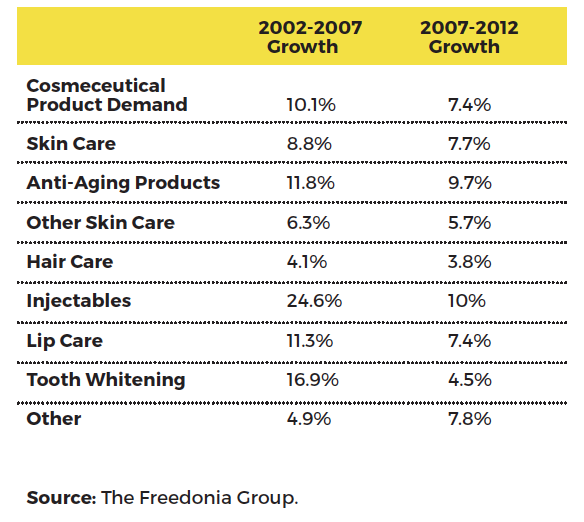Market Growth and Strategy
In 2017, the global market for cosmeceuticals was valued at over 46 billion dollars in the U.S. alone. This figure is expected to almost double by 2023 at an estimated value of over 80 billion dollars. World wide, the United States holds the largest market share of cosmeceuticals, followed by Europe and Asia. For skin care manufacturers, estheticians and spa business owners, understanding why the cosmeceutical industry is experiencing such tremendous growth is vital to reaping the economic rewards.
Let’s uncover the various forces pushing and pulling cosmeceuticals into the hands of consumers and skin care professionals around the world.
The Rise of the Aging Population
Researchers and analysts agree that a large part of the cosmeceutical industry’s growth can be attributed to population growth. People are living longer, and the desire for youthfulness among men and women is feeding the cosmetic industry. In fact, between 2007 and 2017, there has been a rapid increase in the 40 and over population. With life expectancy expected to continue rising for men and women, the aging population is a growing market for skin care and cosmetic companies. This rapidly growing demographic is sparking demand for anti aging products to prevent wrinkles, sun damage, and other signs of diminishing youthfulness. With this increased demand, skin care manufacturers are responding by focusing research and development on active ingredient-based anti aging products to appeal to this growing demographic.
Well-Educated Consumers
Just as the number of aging consumers continues to increase, so does their cosmetic ingredient savvy. Beauty-conscious consumers are now more knowledgeable and wealthier than ever before and are seeking cosmetics with medicinal benefits. This is another reason for the increase in cosmeceutical grade product sales. Consumers are aware of active ingredients, and are now demanding therapeutic concentrations in their over the counter skin care products.
Ingredient Driven
The demand for new ingredients is largely driven by the “baby-boomer” generation. Estheticians whose practice relies mainly on aging clients can attest to their growing concern about their aging skin.
In demand cosmeceutical ingredients are:
• Topical retinoids • Antioxidants • Enzymes • Botanicals
• Hyaluronic Acid • Amino Acids • Peptides
In a market where consumers are growing more and more educated about active skin care ingredients, the importance of continued education and innovation among skin care professionals is more important than ever.

Competition and Innovation
A growing cosmeceutical market encourages competition and demands innovation. It is now vital for skin care manufacturers to separate their product from the masses and get their message to consumers. Extensive marketing is essential for companies that sell cosmeceuticals, as there are often counterfeit and fake products in this unregulated market. The FDA (Food and Drug Administration) does not recognize the term cosmeceutical. However, the Federal Trade Commission (FTC) investigates advertising claims made by manufactures of cosmeceuticals. It is the FTC’s job to examine any claims of pharmaceutical properties or effects for scientific validity. Any claims made by product manufacturers about having an effect on the structure or function of human skin must be substantiated by scientific evidence.
Competition for cosmeceuticals comes from various sectors. Treatments such as laser, which offer more dramatic results than cosmeceuticals but at a greater cost and greater risk, are growing in popularity. Competition from within the cosmeceutical market is increasing as well, with the rise of private label cosmeceuticals and rapid commoditization of active ingredients. With advanced and high quality private label products available to estheticians to bottle and sell, any savvy entrepreneur can grow a successful cosmeceutical brand! That’s great news for estheticians and spa owners!
Selecting Cosmeceuticals for Your Practice
Use your expertise and ingredient knowledge to select effective products. It is also important to evaluate products based on their safety and ease of at-home use. Products that cause significant irritation such as redness or dryness will not be well tolerated by clients.
When considering cosmeceutical brands to carry, look for lines that are not available at mass-market retailers and department stores. Professional lines should be designed for estheticians to create a competitive and exclusive retail environment.
Finally, make sure your entire staff is educated on your cosmeceutical line’s efficacy, usage and ingredient profile.
Sources
F. S. Brandt, A. Cazzaniga, and M. Hann, “Cosmeceuticals: current trends and market analysis,” Seminars in Cutaneous Medicine and Surgery, vol. 30, no. 3













